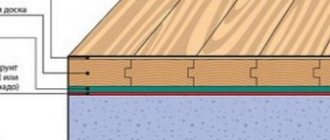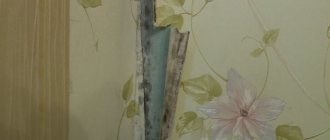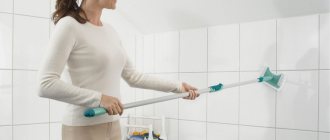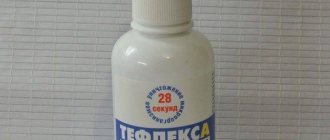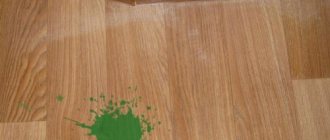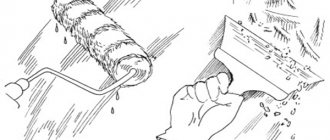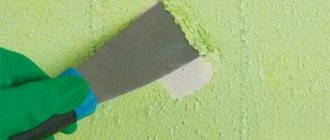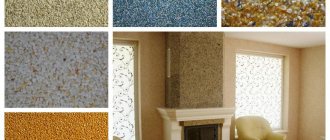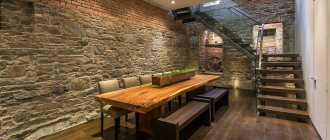How to protect wooden shelves in the cellar from rot
A cellar is a place where harvested crops and canned goods are often stored. The microclimate of the room helps prevent food spoilage. But, it is also good for mold and rot on wooden shelves and racks. There are some ways to protect yourself from these unwanted effects. But, at the same time, it is necessary to eliminate the cause of dampness in the cellar - if this is not done, then any methods of combating rot and mold will be meaningless.
How to remove mold and rot
To prevent rot or mold from occurring on wooden shelves and racks in the cellar, it is necessary to eliminate the main cause of these problems - excessive dampness with stagnant air. The solution to the problem of rotting and molding of wooden surfaces in the underground is always complex. They are removed in several stages, each of which is mandatory; without it, the result will be short-lived.
Preparation
While problems with rot and mold are being eliminated, the subfloor is completely cleared so that there is access not only to all surfaces, but also to protect products from fungi. In addition, they take out furniture and other items that are kept in the basement - they can interfere with processing, in addition, they also need to be disinfected. The premises are thoroughly cleaned, removing all mold.
When fungus or rot has deeply damaged the furniture, then such parts are removed or the contaminated item is completely destroyed. When the floor is earthen, its upper part to a depth of 10-20 cm must be removed, since it also contains fungal spores. After cleaning, the basement is ventilated and dried, and then its immediate treatment and disinfection begin.
Disinfection
Usually, shelves and racks for the basement are made of metal or wood. Metal structures for processing are removed from the underground, since it is undesirable to work with toxic chemical compounds indoors. In the case of wooden structures, they are taken out and dried in the sun - this allows you to destroy fungi on the surface, as well as see the degree of damage to the material. Then all surfaces of wooden racks and shelves are thoroughly treated with a disinfectant solution. To avoid getting poisoned during disinfection, you must follow safety precautions:
- Before starting to dilute disinfecting compounds, put on rubber gloves, safety glasses with a suit, and a respirator.
- You should not touch mold with bare hands, and you should also not inhale its spores.
- Disinfection cannot be carried out in a room with poor ventilation.
- After treatment, leave the disinfected object in the open air until it dries completely.
If signs of poisoning occur - dizziness, nausea, weakness, etc. - you should seek medical help. Intoxication with chemicals is a dangerous condition; self-medication or delaying consultation with doctors can lead to more serious consequences.
Mechanical processing methods
If mold has already affected the walls, boards or ceiling, you need to take immediate measures to eliminate it. To do this, in addition to vitriol and lime, you can use the following means:
- Chlorine powder or bleach, which is dissolved in water. You can apply the product with a brush or spray.
- Soda with vinegar. The surface is sprinkled with dry powder and then watered with vinegar. The resulting reaction destroys microorganism spores.
- Table salt with boric acid. To prepare, take 1 kg of salt and 50 g of acid, combine with a liter of water and treat the moldy areas.
- Potassium permanganate solution. The composition is saturated, after which all surfaces of walls, racks and shelves are treated.
- Tobacco decoction. You will need 50 g of dry shag, from which a concentrated decoction is made.
- Iodine solution. To prepare, take 10 ml of five percent iodine per one and a half liters of water. The mold is removed, then the surfaces are sprayed with iodine.
- Sulfur fumigation. An effective but highly toxic disinfection method. Containers with sulfur are placed in the cellars and set on fire, the basements are hermetically sealed. Gas kills mold and destroys fungus.
When using toxic substances, you need to wear protective equipment - gloves, special clothing, respirators. It is believed that once microorganisms appear on wood, it is no longer possible to get rid of them, and all that remains is to burn the tree completely.
Preparations for disinfection
A large number of disinfectant compositions have been developed that can solve the problem of rotting and molding of wooden surfaces. There are also folk remedies. However, the main thing in the disinfection process is to follow safety precautions, not to work with disinfectants indoors, and to use personal protective equipment during processing.
Formalin
Wooden racks and shelves are treated with a formaldehyde solution. It is made from 40% formaldehyde, take 0.25 ml of the drug and dilute it in 10 liters of water. A cloth or cotton swab is moistened in the solution, then the wooden surfaces are carefully treated without skipping. Work with this solution only with gloves, a respirator, and a protective suit.
Bleaching
They use chlorine-containing products, Sanita, Domestos, Belizna, and other similar household preparations are suitable. The products are used undiluted; they are applied to the surface affected by rot or fungus with a spray bottle, sponge or paint brush. The product is left on the wood for at least 10 minutes, and then cleaned off with a metal brush or spatula, leaving the furniture to dry in the fresh air for 2-3 days. If necessary, repeat the treatment.
Dezaktin
A powder preparation that is used to disinfect various surfaces or objects. To eliminate rot or mold in the cellar, Dezaktin is diluted according to the instructions. All surfaces are thoroughly treated with the prepared solution, without skipping. Then the disinfected furniture is left to dry outside. It is also advisable to treat with Dezaktin solution inside the basement.
Fumigation with sulfur
To eliminate mold in the underground, sulfur fumigation is carried out. To do this, everything is taken out of the basement. When there are some metal structures in the cellar that cannot be removed, they are thickly lubricated with grease. After preparation, a sulfur bomb is placed inside the room, which is set on fire. You must leave the cellar as quickly as possible, as the smoke is toxic. The combustion continues for up to 1.5 hours, then the underground cannot be opened for another day. After 24 hours, you need to ventilate the basement so that the sulfur smell completely disappears. Usually this takes up to 2-3 days.
Folk remedies
An alternative to drugs are traditional methods. Most of them are always available. But such methods will not always be effective; if the affected area is large, it is better to use chemicals for disinfection. Among the products used, they help eliminate mold and rot that affect wooden shelves or racks, such as:
- bleach and slaked lime in equal parts, diluted with water;
- lime-formalin solution - lime 0.5 kg, formalin 0.2 kg, 10 l of water;
- slaked lime (0.5 kg), 50 g of copper sulfate and 10 l of water;
- citric acid (100 g) dissolved in 1 liter of water;
- boric acid with hydrogen peroxide, vinegar and water (1:2:2:4);
- copper sulfate (100 g), diluted in 10 liters of water;
- grapefruit extract (10 drops), diluted in 200 ml of water.
Choosing an anti-mold product
To remove mold in the cellar, it is necessary to treat all mold-affected surfaces with a special product.
- In any hardware store you can easily purchase specialized antiseptics that have an antibacterial or antifungal effect. Such drugs must be handled with extreme caution, strictly following the instructions.
They are toxic, so failure to comply with safety precautions can lead to negative consequences for the health of the cellar owner.
- Plain whitewash is widely used as one of the most effective ways to remove fungus in the cellar. It contains a number of chemical components that destroy mold.
- If mold appears in the cellar, most seasoned “fungus fighters” recommend using ammonia.
- An effective assistant in destroying fungus in the cellar is a concentrated solution of citric acid. Two hundred grams of lemon powder must be dissolved in two liters of water, and then treat the areas where mold may appear or has already appeared with the resulting mixture.
- Two kilograms of quicklime and two hundred to three hundred grams of copper sulfate, dissolved in thirty to forty liters of water, will help quickly get rid of mold in the garage cellar.
- The most common answer to the question - how to get rid of mold in the cellar effectively and quickly - is a sulfur bomb . Set on fire and left for several hours or overnight in a stable metal container, it will help to quickly destroy the fungus in the cellar.
- One kilogram of salt and one hundred milliliters of boric acid, dissolved in five liters of water, are very toxic to the fungus and will help to remove it easily.
- Formalin and bleach in an amount of fifty grams of each chemical, dissolved in two liters of water, are effective in combating white mold.
- One of the simplest ways to get rid of mold is to treat the areas where it accumulates with an ordinary burner . However, you should not try to get rid of mold on wood in this way - there is a risk of not only killing the mold, but also spoiling the material.
This is also interesting: Mold stains on a baby stroller: what to do?
Conditions to prevent rot and mold
To rid wooden shelving and shelves in the basement from rot and mold, you need to create a normal microclimate. If you do not create conditions that are not suitable for the reproduction and development of mold fungi, then the wooden structures in the cellar will rot, regardless of the frequency of treatments carried out in it and the means used. What should be done:
- improve ventilation;
- perform waterproofing;
- reduce air humidity.
A well-maintained, equipped, disinfected cellar is a good place to store supplies for the winter. Wooden structures - shelves and racks - will not rot in it. If such a problem already exists, then all the furniture is removed from the underground and treated. At the same time, do not forget to disinfect the basement, as well as provide good ventilation, waterproofing and reduce air humidity.
Source
Why is mold dangerous?
Mold spores get into the pores of building materials, grow, and the mycelium destroys them. If you do not destroy the fungus in the subfloor or basement of a non-residential dacha, the parasite will spread to other rooms and the foundation. Wooden houses are the most vulnerable to damage.
We suggest you read: Cleaning filters in a washing machine
Harm to humans
As molds grow, they release spores containing toxins that become airborne and enter the lungs. When in contact with harmful substances for a long time, a person experiences ailments:
- headache;
- cough;
- asthmatic syndrome;
- irritability;
- allergies.
If they get into food, mycotoxins cause poisoning, so moldy vegetables from the cellar should not be eaten.
You can eat products in glass jars from a cellar infected with mold if the lid is not damaged, but first the containers are washed and wiped with vinegar
How to treat wooden shelving in a cellar to prevent it from rotting?
Unfortunately, very often all kinds of wooden structures that the owner makes in the cellar last a short time. Wooden shelves, bins, racks, supports, racks and other important elements are subject to rotting, fungus, destruction, and emit an unpleasant odor. Or they may fail, destroying all the summer preparations. How to extend the life of wooden structures?
First of all, you need to deal with high air humidity, which is certainly present in the basement if the wood begins to rot. If there are communications (water supply, sewerage) in the basement, check for leaks or condensation. Any leak, even a minimal one, must be eliminated.
Also, high humidity is formed due to the lack of ventilation or its ineffective operation. In any basement, even the smallest one, it is necessary to equip it with ventilation so that there is air exchange. Usually a pipe is installed that leads outside from the basement. In winter, the hole in the pipe is well closed. In summer, the basement needs to be kept open for at least some time to dry it out. It is advisable that vents be equipped in the basement walls.
It also matters how high the groundwater is and whether it leaks onto the floor surface in the basement. If there is such a phenomenon, then the floor needs to be raised - covered with slag, gravel, compacted and filled with concrete.
Be sure to check if the waterproofing layer has collapsed. The destroyed layer needs to be restored.
To protect wooden structures, boards and bars must first be thoroughly dried and then covered with several layers of drying oil. You can leave it like that, or you can paint it with protective waterproof paint or paint materials.
After this procedure, they can be used to arrange a basement (cellar). Drying oil and paint will help preserve the wood for a longer period.
Experts recommend wrapping wooden structures with waterproofing materials, for example, roofing felt, plastic film, glassine, roofing felt will also work.
If the floor in the basement is earthen, then under each wood structure it is worth making a concrete or other protective base. Wood will rot faster from the ground than from a concrete castle.
Source
Treating walls and wooden cellar structures against mold
Dampness, mold on the walls, rotting boards, stale air - similar theses can describe almost any basement, regardless of its location. This is due to completely objective reasons - high levels of humidity and poor ventilation provoke the development of colonies of fungi and bacteria.
Such microflora not only destroys building structures, but also negatively affects the health of people living in the house. In this regard, every homeowner must take care of the effective, correct and timely treatment of the premises with antiseptic agents. During the processing process, special attention should be paid to wooden surfaces (boards, bars, slats), metal and soil bases.
It must be remembered that it is not enough to treat the walls and shelves in the cellar once. Such work must be carried out systematically. The frequency of basement treatment will depend on the degree of exposure to groundwater, the level of humidity in the room, its area and other factors.
Methods for getting rid of mold in underground storage facilities
Regardless of the room in which the fungus appears, the cause of the increased humidity is first determined and eliminated.
If the affected areas occupy a small area, the surface is cleaned of mold and impregnated with an antifungal agent. If the situation in the basement or cellar is neglected, you will need:
- apply strong antiseptics;
- warm the room with warm air;
- repair the floor, walls and replace damaged wooden shelves;
- improve ventilation.
When working in a heavily mold-infested cellar, you should wear a protective suit, mask and respirator.
Deep penetration compositions
The main method of preventive treatment of basements of residential buildings is the use of special impregnations that penetrate deeply into the structure of the material. Such impregnations are used to treat house structures at the stage of its construction and, as a rule, contain antibacterial components. The penetrating composition forms microscopic crystals in the structure of the material and prevents mold from developing.
Surfaces are treated with a deep penetration primer at the construction stage of the premises.
On the modern market, deep penetration impregnations are produced for certain materials (for example, wood, concrete bases, metal). Impregnation components are specially selected for the best interaction with certain types of surfaces.
However, even the highest quality primer will eventually cease to cope with its functions, because the active substances will no longer work. In this regard, it is recommended to treat surfaces and structures in the cellar at a certain frequency (usually indicated on the packaging). It is also worth considering the fact that if the surface of the material is already infected with fungus, impregnation will not help.
What you need to know about mold protection
The protective composition should be selected based on the operating characteristics of the surface being protected. Only hard-to-wash coatings are suitable for outdoor use. Such products will reliably protect wood for 30 years.
For wet rooms (basements, baths) special products are needed that can withstand sudden temperature changes.
Changes in the color of the wood, the appearance of chips and cracks are a signal that the protective coating should be urgently renewed. It is recommended to alternate antiseptic compounds without treating the wood with the same compound again.
Copper sulfate solution
The most popular means used to disinfect the surfaces of basements and cellars is copper sulfate. This is an accessible, inexpensive and quite effective product, so it is perfect if you need to treat large basements and cellars.
Copper sulfate crystals are diluted with water.
- Copper sulfate is usually sold in tightly closed plastic packaging. The product itself is blue crystals. Before processing, these crystals in an amount of 100–150 g must be dissolved in a liter of water (detailed instructions are indicated on the packaging; the ratio of components depends on the manufacturer of the substance).
- The main advantage of copper sulfate, in addition to its low cost, is that it can be used to treat boards, metal surfaces and any other substrates, even if there is high humidity and even dampness in the room. True, in such situations it is necessary to increase the number of crystals per liter of water. After the work, a layer of whitewash will be formed on the treated surface, which will prevent the formation of mold colonies and fungi.
- Experts recommend treating surfaces with copper sulfate annually to obtain highly effective results.
When using this solution, processing must be carried out using protective equipment (after work, the room must be thoroughly ventilated). Despite the fact that copper sulfate is quite popular, during the operation of the basement it will release harmful substances into the air, so it must be used with caution.
What to do if fungus has already formed in the basement?
First of all, it is necessary to completely remove traces of its presence. For this purpose, the room is completely vacated:
- all boards and other wood are removed;
- garbage and unnecessary rubbish are thrown away;
- shelves and partitions are removed.
It is recommended to keep all elements of the basement arrangement in the sun for some time, treat it with a soap solution and dry completely.
Before processing, boards removed from the cellar must be cleaned, washed with soapy water and dried.
The cellar itself must be completely opened to allow the room to ventilate, dry and warm up. It is best to carry out such work in the summer, when it is dry and there is no rain. The duration of ventilation will depend on the degree of fungal damage to surfaces. On average, they usually ventilate for 1–2 weeks, without breaks, without closing the doors or hatch.
After the basement is completely ventilated and dried, it is necessary to treat the surfaces and structures using a special product. Any compositions and substances mentioned above can be used. To increase the effectiveness of the treatment, it is recommended to leave the basement open for several days after work.
To completely eliminate the possibility of mold formation in the future, it is necessary to improve the operation of the ventilation system and ensure that ground and sediment water does not penetrate into the room. A variety of materials can be used to waterproof cellars and basements - everything will depend on the capabilities and requirements of the homeowner.
Treating basements, cellars and other underground rooms with high humidity against mold is a mandatory measure that should be preventive and not emergency.
Assistant editor, author of articles on general economic topics.
Source
What to do if the timber begins to rot
Rotting greatly deteriorates the physical parameters of the tree. Its density drops by 2–3 times and its strength by 20–30 times. It is impossible to restore a rotten tree. Therefore, the element affected by rot should be replaced.
If the mold infestation is minor, you can try to stop the process. To do this, the rotten area is completely removed (including part of the healthy wood). The removed part is replaced with steel reinforcing rods, which must go deep enough into the healthy part of the element. After reinforcement, the area is puttied with epoxy or acrylic putty.
This is a labor-intensive and complex procedure, after which it is not always possible to achieve the previous strength of the structure. The problem is easier to prevent by treating the wood to prevent rotting.
How to Treat a Basement Against Parasites: Detailed Instructions
Treatment of cellars to protect against mold and fungi is necessary every year. Usually it is cleaned, washed, ventilated and, if necessary, disinfected. All work related to disinfection must be carried out at least a month before storing products in the cellar for storage.
It is not recommended to use a solution of bleach concentrated above 4%, otherwise the products may acquire a specific taste. What kind of cellar treatment is needed before planting vegetables is suggested in this article.
What are the main methods of maintaining basements?
Before treating the cellar, you need to choose the right time. It should be a warm sunny day, which means it is necessary to ventilate the room and dry everything in it.
Then the process of preparing the basement for food storage is as follows:
- The floor is thoroughly swept with a stiff brush. There should not be a single gram of soil or any vegetable residue left on it and on the existing shelves from last year.
- The room is ventilated for several days with the door and all existing ventilation holes wide open.
- Treating the cellar with copper sulfate allows you to quickly and quite simply remove existing fungus and mold and prevent their further spread and occurrence. The photo clearly shows how fungus works in the basement.
Damage to basement elements by fungal infection
To achieve these goals it is possible:
- Treatment of the cellar with a sulfur bomb, but on the condition that the instructions for its use are strictly followed.
In a well-ventilated, dried and thoroughly cleaned room, only one bomb is enough; it will only have an effect on the possible occurrence of fungus and mold.
Advice: If after cleaning the basement it was not possible to completely remove all harmful microorganisms, then it will be necessary to carry out the treatment a second time.
- The simplest remedies - baking soda and vinegar - can help get rid of more types of mold.
Mold and mildew on basement walls and floors
- Use of special solutions. Most often, a steep solution of potassium permanganate is used for these purposes. The work is carried out with your own hands using a sprayer or broom.
Advice: When carrying out operations, do not neglect the use of personal safety equipment. It is necessary to protect the skin, eyes and respiratory organs. Be sure to wear rubber gloves, a face mask and clothing that covers all areas of the skin.
- After this, the cellar is closed for two to three days, then everything is opened again to ventilate it. You should not enter the cellar at this time.
- An audit or assessment is carried out to see how well the potassium permanganate solution managed to cope with the task.
Mold prevention
One of the most important criteria for determining where mold and mildew appears is moisture. In a damp room, there will always be favorable conditions for the development of fungal spores, while a well-ventilated room will be reliably protected from their appearance.
To ensure the necessary dryness and ventilation of the room from dampness and fungus, it is necessary to leave the cellar door open every day for at least twenty to twenty-five minutes. In the absence of the opportunity to repeat this procedure every day, two pipes should be installed in the cellar: one from the floor, and the other from the ceiling. Thanks to them, fresh air will be able to constantly enter the room, and its owner will finally have no reason to fear. So, how to get rid of mold in the cellar?
- To get rid of moisture, you must also move all furniture away from the walls. This will prevent condensation from forming.
- Heaters will help get rid of damp, humid air in the cellar.
- For the same purpose, you can use heated ceramic bricks, white moss or vessels filled with quicklime. They absorb moisture perfectly.
- All containers containing liquids or products must be tightly closed..
- Good waterproofing will help protect the cellar from moisture from the outside. It is recommended to protect the floor, walls and ceiling from moisture using moisture-proof material.
Despite their apparent harmlessness, molds are very dangerous and harmful.
The fact that they cause aesthetic discomfort by covering walls, floors and ceilings in accumulations resembling sticky white fluff or snow is only a small part of the harm they cause to people. The favorite habitat of mold is food. Once the fungus appears on them, you can no longer eat them: this is fraught with serious, severe forms of poisoning. However, even irreversible spoilage of food cannot be compared with the main danger of the appearance of mold fungi.
This is also interesting: Mold on clothes: removal methods and preventive measures
These tiny organisms release the products of their vital activity in the form of gas and spores - microscopic particles that fill the air in quantities of about two to three million per twenty grams of dust. These particles enter the human body through the respiratory tract and skin, causing coughing, allergic reactions, chronic runny nose, conjunctivitis, hair and nail damage, bronchial asthma and intoxication. Mold is very tenacious: it does not require any special conditions for germination.
The only condition is air humidity and access to water, which allows the fungus to form mycelium (a kind of mycelium) anywhere: on concrete, wood, fabric (clothing), soil, food. Therefore, you should not think that fungus that appears in a cellar or basement will remain there and will not become a problem for the owner of the premises. These simple organisms multiply incredibly quickly and can go beyond the cellar, settling directly in the owner’s house, jeopardizing the health of himself and his family.
How to properly treat a basement
To store a large number of different vegetables and some fruits, some features must be taken into account.
In this case it is necessary to determine:
- How to treat boards in the cellar that are damaged by fungus, which mainly concerns the floor. But the floor in the cellar is most often filled with concrete. Therefore, in this case, it is enough to simply wash it with a disinfectant solution and install special racks for storing vegetables and fruits.
Tip: Do not place boxes directly on the floor or on top of each other. Here the air will not circulate at all, which will create quite favorable conditions in which harmful bacteria will multiply.
- What kind of racks will be installed, will it be necessary to pre-treat the cellar boards or will the shelves of the racks be made of mesh?
- It is necessary to place boxes on them that have holes for ventilation.
- Boxes can be put together with wooden legs, with pre-treatment of the material with an antiseptic.
- You can place bricks under each box so that there is at least 5 cm of distance between the floor and the bottom of the box.
- When placing them on top of each other, vegetables or fruits must not be poured to the edges, but left empty space on top, which will provide air ventilation in the boxes.
Treatment of cellar walls
Before treating the walls in the cellar, it is necessary to consider issues related to the use of products for the specific type of material from which they are made.
Tip: Before processing a metal cellar, you should check the quality of the welds. If defects are detected in them, any methods other than high-quality welding will not help get rid of the formation of dampness in it.
- Then, after checking all the seams, and if necessary, welding them on both sides, the iron cellar is treated with a special anti-corrosion coating.
- The simplest way to treat cellar walls is to use a lime mortar with the addition of iron or copper sulfate. The ratio of the weight of vitriol to the weight of the solution is taken to be 1:10. After this, all surfaces must be whitewashed. In places that are difficult to access with a whitewash brush, the cellar is treated with lime by spraying it using a rubber bulb or a spray bottle.
Treating walls with lime mortar
The advantages of using this mortar include:
- Low price material. It’s simply not possible to find something cheaper, and at the same time high enough for finishing walls, for those who have a cellar.
- Lime has good antimicrobial properties - almost all bacteria that get on the surface die after its treatment.
- The material is moisture resistant and does not crack due to temperature changes. Treating wood in the cellar with slaked lime permanently rids the cellar of the formation of fungus and mold; such microorganisms do not settle here.
- Lime is safe for health, it does not have a strong odor, it does not emit elements harmful to breathing; on the contrary, after using lime, the room is partially or completely disinfected.
- The solution can be applied to old whitewash and to new walls.
Tip: A feature of slaked lime is its good miscibility with any dyes. When diluted with paint, it can acquire any shade that suits the owner of the room.
- To disinfect the floor, you need to sprinkle it with a small layer of fluff lime.
- Before treating your basement against insects, you should prepare and complete:
- take from two to three kilograms of quicklime lumps of lime;
- pour it into the tank;
- to fill with water; quickly get out of the cellar;
- the hatch is carefully closed or even coated with clay for tightness.
Lime vapors generated during slaking have a detrimental effect on insects and can suppress the activity of putrefactive fungi. The room is left closed for two days, then thoroughly ventilated. This treatment of the cellar is usually carried out two or three times.
Advice: Lime fumes have a harmful effect on human health, which requires precautions when working with lime.
Copper sulfate treatment is useful for walls. The basement then dries well. The boards can be processed first. In this case, the cellar is cleared of wooden shelves and racks, which are taken upstairs, washed with hot water with the addition of soap and soda and dried well.
Processing and drying boards from the basement
In case of severe damage by mold or fungus, the boards are replaced with new ones. How smoke is used to treat basements can be seen in the video. All operations to disinfect the cellar must be completed a month before the start of storage of food products.
Victor Martovich
He worked as a foreman, head of the construction and installation site. Organization of work and supervision of the quality of construction and installation works of construction sites on the territory of the Balakovo NPP, maintaining and submitting as-built documentation (magazines, acts, documents), purchasing materials, equipment (performing the duties of a supply engineer, quality engineer). Management of construction teams (registration, training in labor protection and industrial safety). Victor completed training courses under the program “Major repairs of buildings and structures. Organization of work and construction control.”, 2015 Balakovo Institute of Professional Retraining and Advanced Training, Occupational Safety and Health Specialist, 2012 Pugachevsky Irrigation College, construction technician, 2000 prof. school, accountant, 1996
Source
